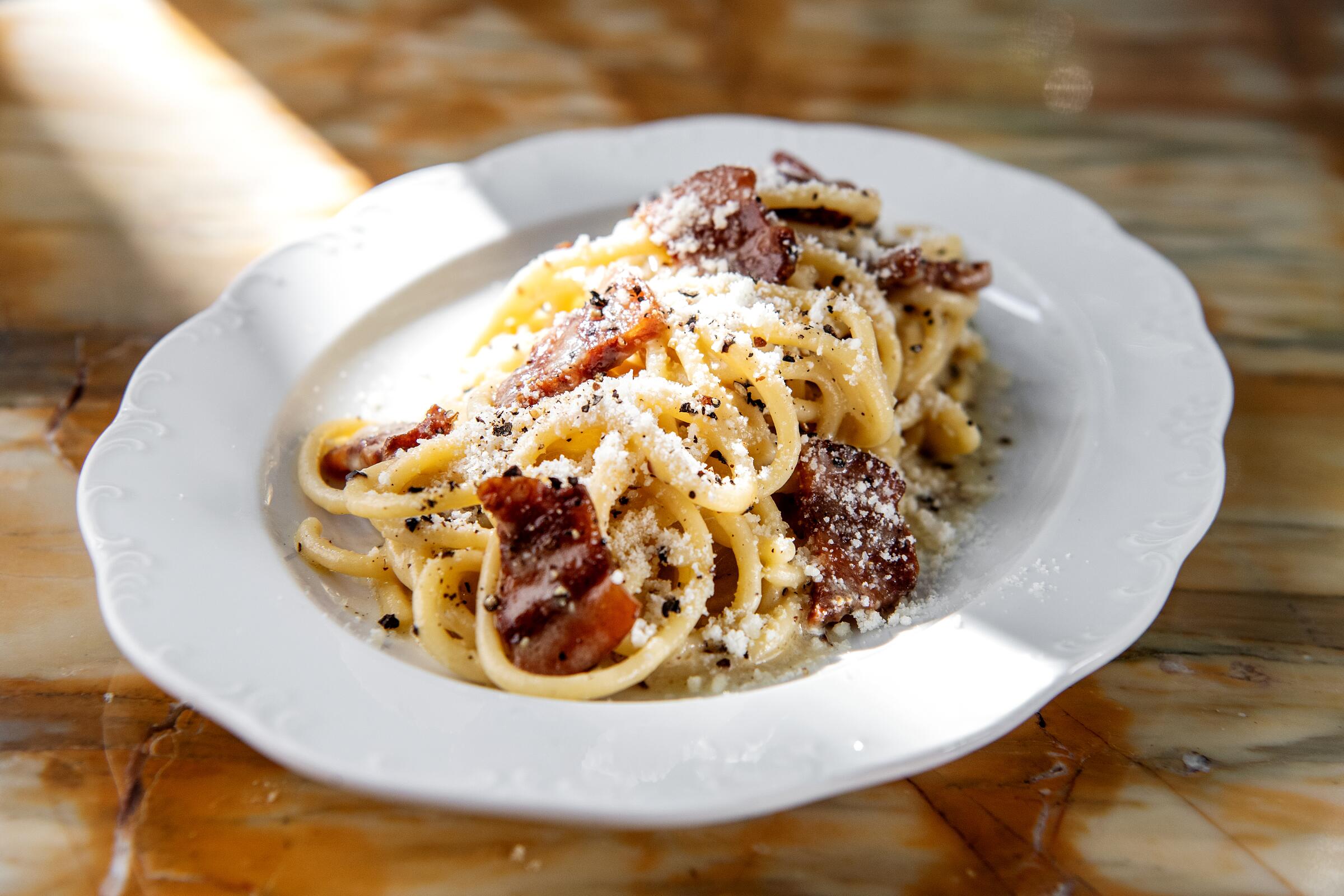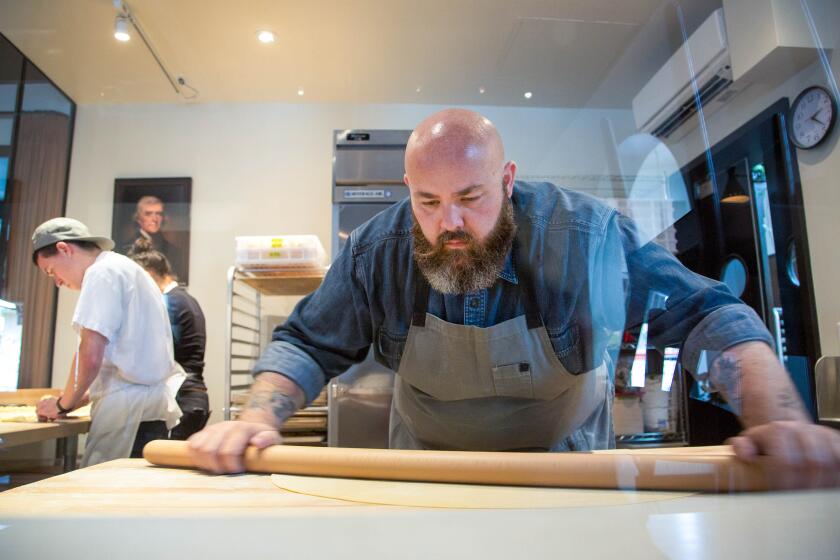Bill Addison is the restaurant critic of the Los Angeles Times. He is recipient of the 2023 Craig Claiborne Distinguished Restaurant Review Award from the James Beard Foundation, among numerous other accolades. Addison was previously national critic for Eater and held food critic positions at the San Francisco Chronicle, the Dallas Morning News and Atlanta magazine.
Pasta maestro Evan Funke creates a Hollywood sensation at his new paean to Roman cooking
1
Malia Obama floats through the mobbed bar area at Mother Wolf, then disappears behind the opaque glass of a discreet side door. The gossip reaches our table: Michelle Obama and Beyoncé are dining in the back room. We suddenly see the signs everywhere. Straight-faced Secret Service types are roaming among booths, pressing on their earpieces. The Beyoncé obsessive at my table spies her bodyguard a few yards away.
Even by Los Angeles standards, that’s a power summit. And I’ll relish the details later. Right now, I’m too absorbed in the spaghettone alla gricia twirled around my fork. It’s a pork-besotted masterpiece.
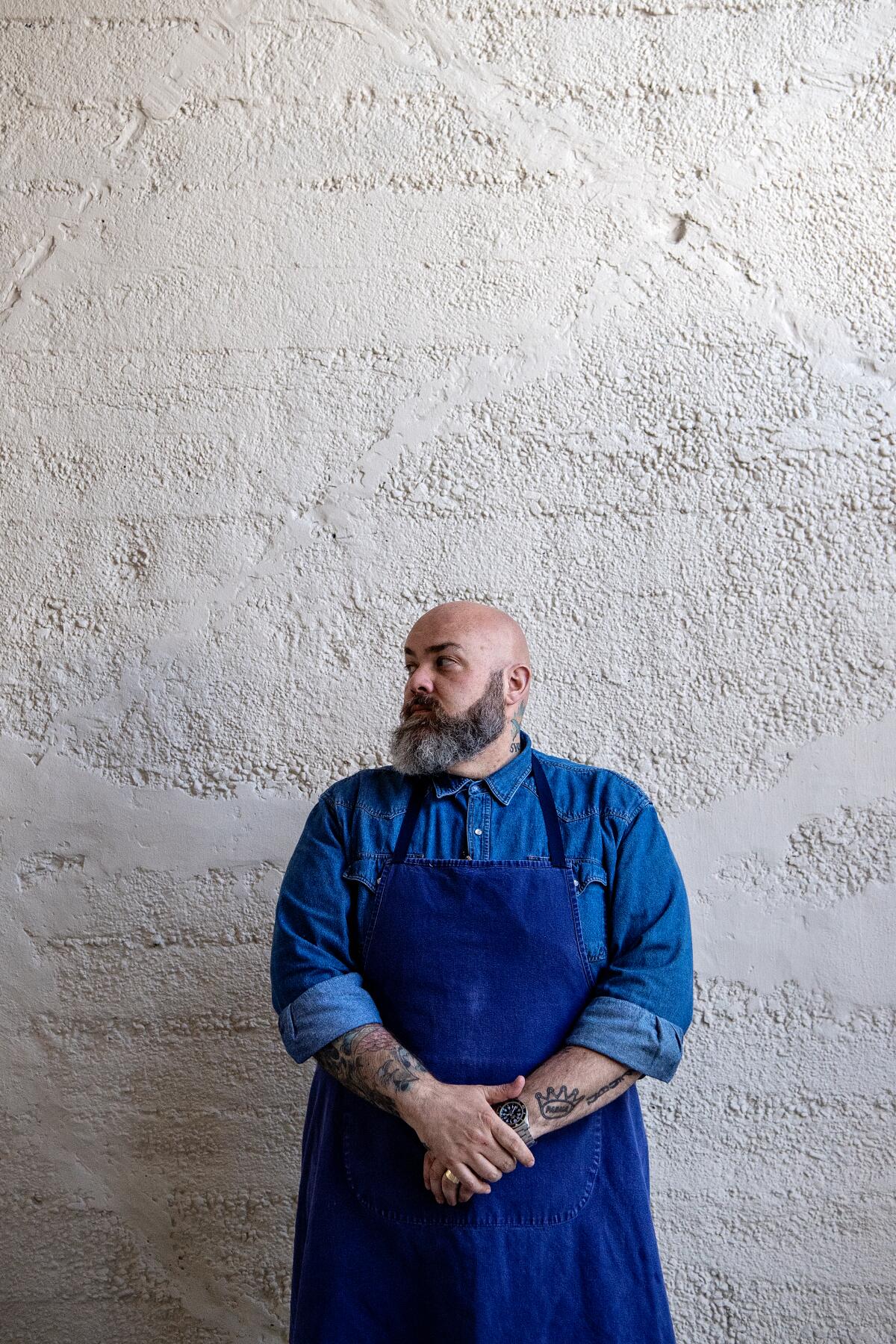
Evan Funke, chef-partner of Mother Wolf.
(Mariah Tauger / Los Angeles Times)
Among the four pillars of Roman pastas, gricia gets the least play by far in the United States. As with the other three mainstays — cacio e pepe, carbonara and amatriciana — its ingredients are simple and the technique crucial. Slice guanciale into short ribbons, crisp it in a pan and stir in enough roughly crushed black pepper for a pleasant burn. Whisk the rendered fat in a fury with hot water to achieve a glossy sauce. Toss in spaghettone, which is the choice here, or another long strand of similar thickness, or a tube shape like rigatoni. Finish with sharp pecorino Romano.
The version here rightly sings of the cured pork jowl’s barnyard funk, which the cheese both augments and smooths. Its precision is no surprise. Evan Funke is among the country’s most pasta-obsessed chefs, the depths of which came most sharply into focus when he opened his hit Venice trattoria Felix: He installed a glass chamber where pastas are rolled in the center of the dining room.
Plus new vendors for Smorgasburg’s return, a Valley bar expands and more.
Mother Wolf is a different animal altogether. Celebrities, most of them not ensconced in a private room, and Hollywood players have poured through the doors since the restaurant’s first week. Perhaps a preopening listening party held by Kanye West soon after he officially changed his name to Ye set the tone.
There is often an only-in-L.A. disconnect between “industry restaurants” and “serious restaurants,” an odd juxtaposition of broadly pleasing menus and VIP pampering and other case-by-case intangibles. Funke — an L.A. native who spent formative years learning from Wolfgang Puck at Spago and whose father is an Academy Award-winning special effects photographer — has an insider’s instinct for coddling the Hollywood elite.
Yet any Los Angeles restaurant obsessives familiar with Funke’s cooking also know he’s a perfectionist. The challenge he’s given himself with Mother Wolf is a rich one: Can he manage the vortex of power and glamour he’s created while maintaining his culinary ambitions?
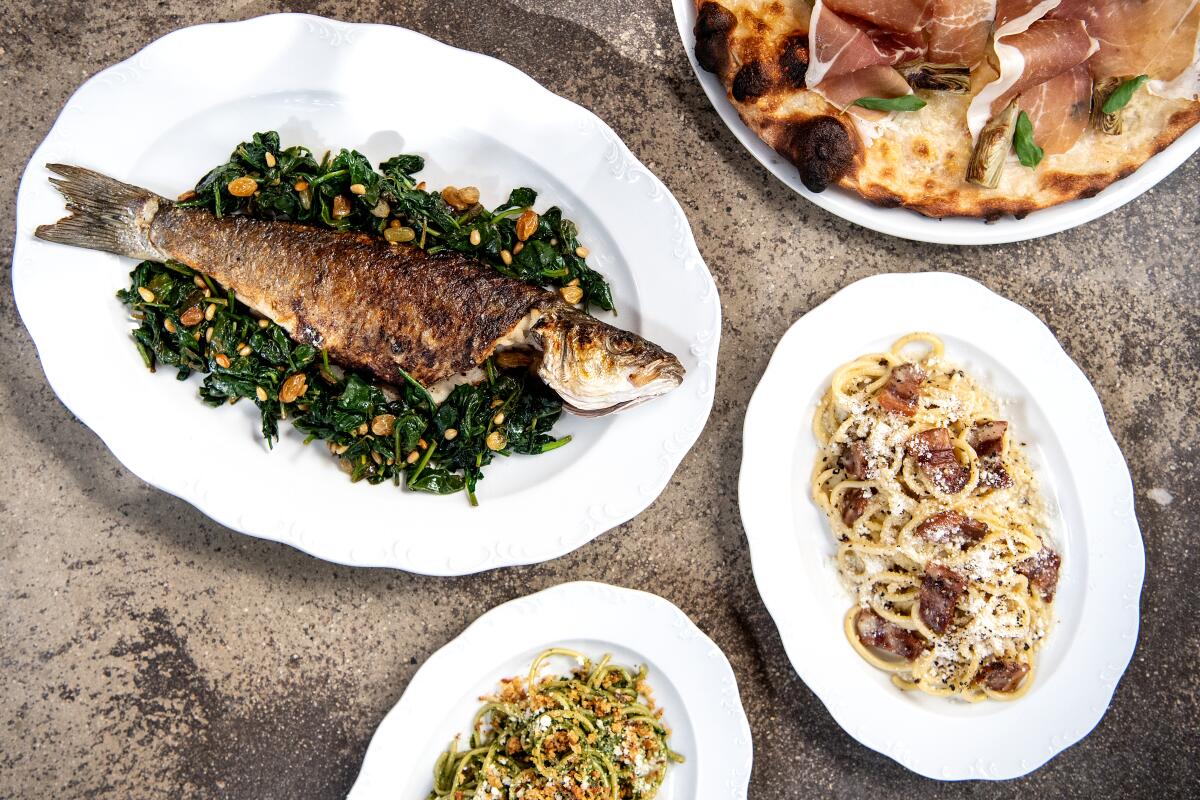
Branzino alla brace, carciofi e prosciutto pizza, spaghettone alla gricia and bucatini con cicoria from Mother Wolf.
(Mariah Tauger / Los Angeles Times)
The solid framework of his Roman menu will help; it’s a regional focus he’s previously workshopped. At Felix, Funke surveys the breadth of Italy, serving tagliatelle al ragù alla Bolognese alongside a Sicilian classic of spaghetti covered in anchovies and bread crumbs and a whopping Florentine-style rib-eye.
Through the fall of 2020, he tested a pop-up menu focused on Roman pasta and pizza in a covered garden space adjacent to the Dream Hollywood hotel. He called it Fingers Crossed. It was supposed to be a six-month residency, but the surge of COVID cases during the holiday season curtailed its run.
Meanwhile, the same development group that renovated the Dream was already at work restoring a 1930s-era Art Deco building around the corner that once housed the Hollywood Citizen-News. A new partnership solidified. Mother Wolf, occupying 8,600 square feet of its ground floor, opened four months ago.
Funke’s pasta fanaticism has already been the subject of a documentary, centered on his years of study in Italy, his command of handcrafting dough into dozens of shapes and the 2017 opening of Felix.
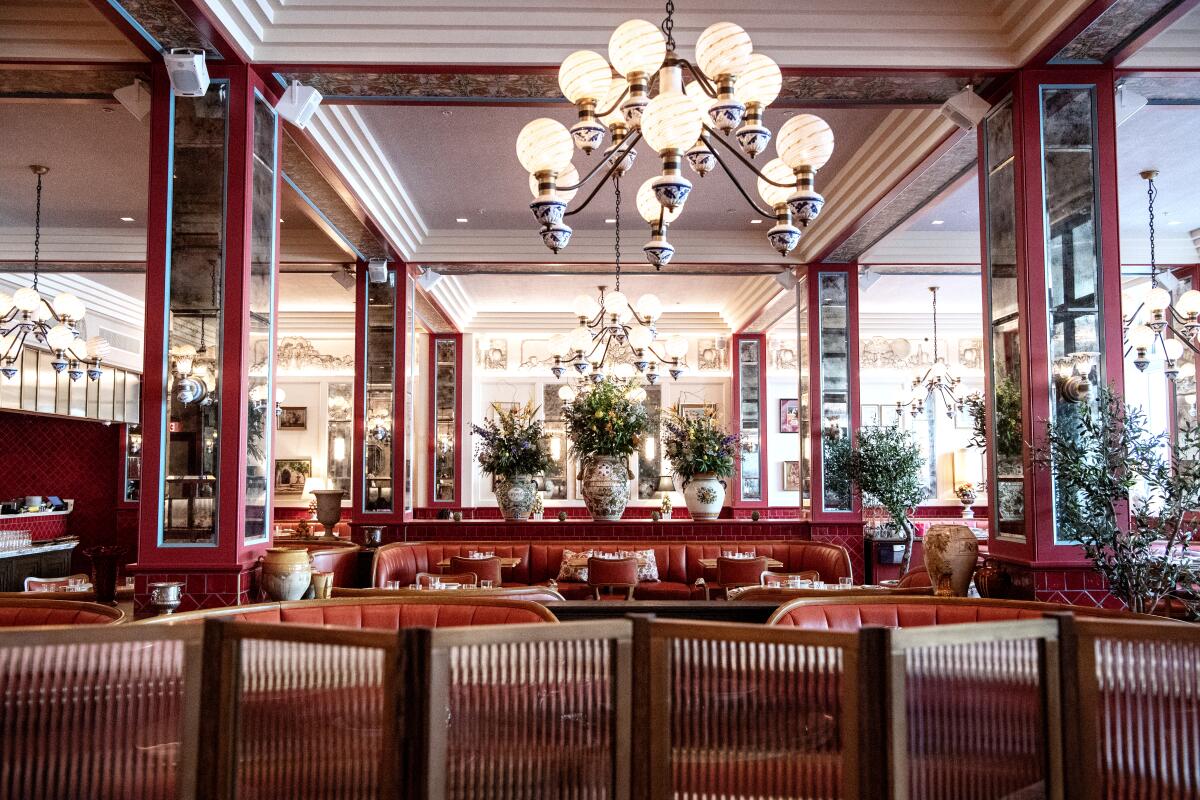
Inside the dining area at Mother Wolf.
(Mariah Tauger / Los Angeles Times)
If another film were to focus on his newest restaurant, it might open with a close-up of the gricia in progress. Funke, with his trademark salt-and-pepper beard and blue denim shirt, would be adding a handful of blanched fava beans as the guanciale sizzles, perhaps noting that this springtime addition is the only acceptable variation to Roman canonists always up for an argument.
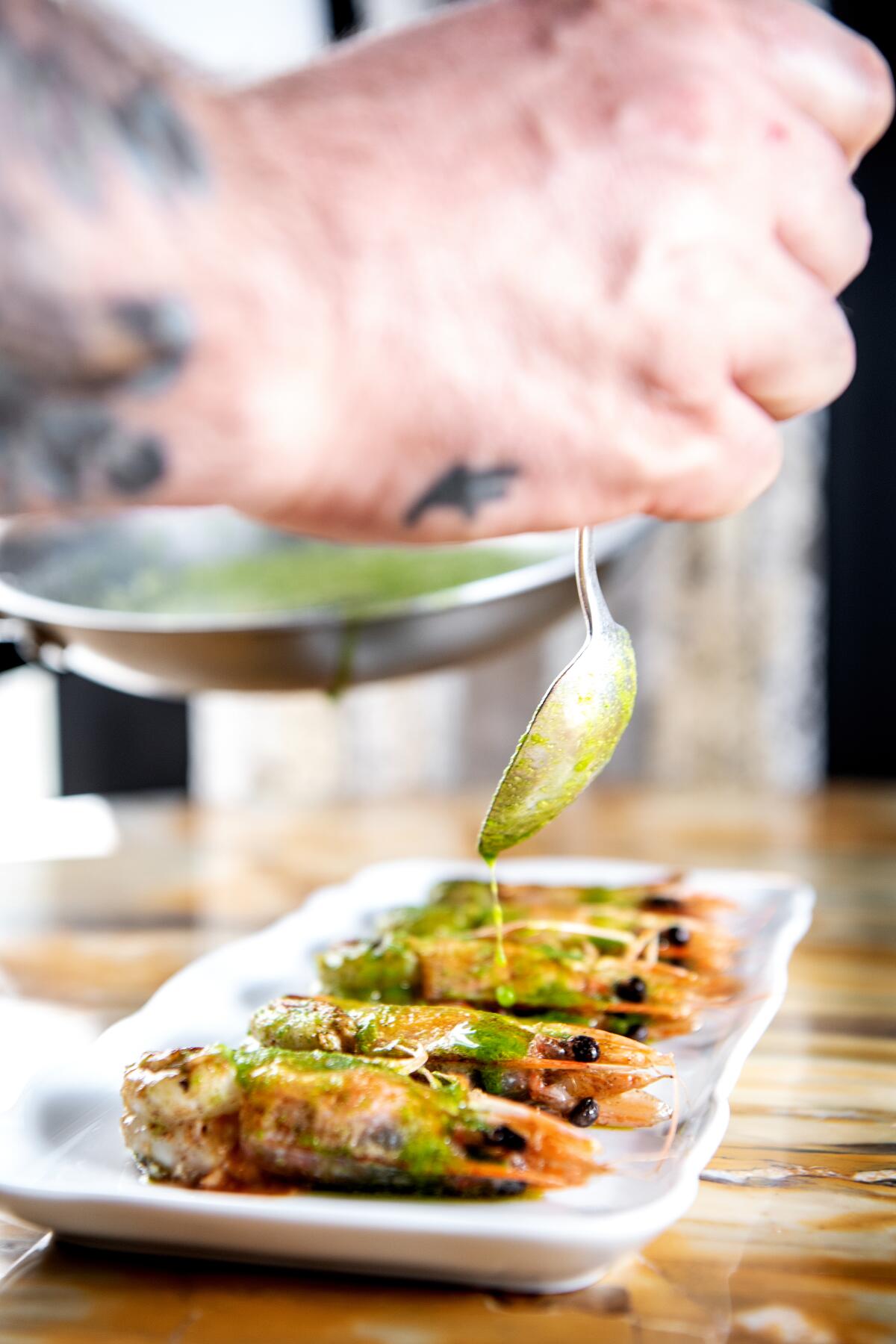
Chef Evan Funke dresses gamberi in salsa verde.
(Mariah Tauger / Los Angeles Times)
The camera would pan over Funke’s shoulder for a full-circle view of dinner service in action. Flames erupt from the grill in the back of the open kitchen. A sweep of the opulent 150-seat dining room: candy apple-colored tiles and brick-red leather, gilded Murano blown-glass chandeliers, smoky mirrors, knotty hardwoods and etchings of pomegranates and lemons around the borders of the sky-high ceilings. Bodies in motion start to blur as daylight fades beyond the picture windows.
Cue the noise level: a wailing crescendo of voices and clattering silverware. The scene closes with Funke draping the gricia onto an oblong plate; it leaves the kitchen among a swarm of servers bearing tomato-laced pastas, handsome round pizzas, fried artichokes and the occasional platter of grilled sea bass on a bed of lemony spinach.
Elements of the cinematic spectacle can bring to mind Paris’ larger brasseries, or one of Manhattan’s seats of privilege, or certainly the over-the-top fantasias that populate the Las Vegas strip.
But really, Mother Wolf is a Hollywood production in every sense. Every night is a party, loud and posh and rowdy enough even for a critic dining out most evenings during an ongoing pandemic to think at times, “OK, this is a lot.” But just try to score a reservation: The restaurant takes reservations only seven days ahead, and you’ll need to stay up until midnight when booking goes live. Tables disappear in minutes.
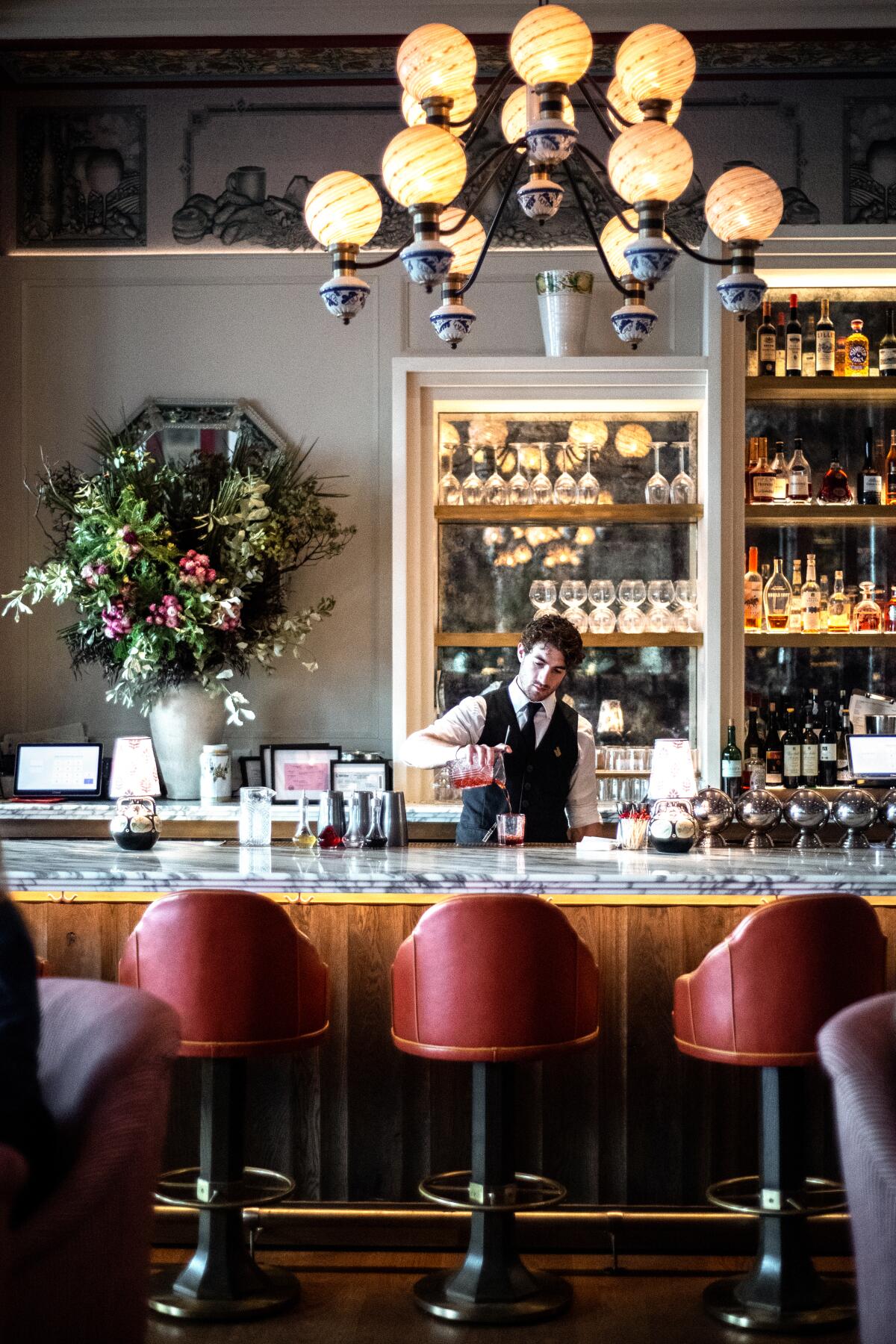
A view of the bar during service at Mother Wolf.
(Mariah Tauger / Los Angeles Times)
As soon as you’re seated, service tends to proceed graciously and efficiently. The need for the staff to maintain a certain pace is palpable. Start with a drink? A Negroni might be an obvious choice among the cocktails, but consider the S.P.Q.R., a vodka martini that wins over this gin drinker with its pheromone of orange blossom water.
A sommelier will likely swing by to introduce himself. He’ll give a speech about the Italian wine list being proudly superb, especially by the benchmark of most Hollywood restaurants. You suspect he delivers the same soliloquy over and over, approaching it like an actor exploring fresh line readings.
And the somm team does expertly guide you through a labyrinth of prices, regions and style; an herby, apple-scented Falanghina from Campania might carry you through an evening as happily as it did me.
Starters set the Roman sense of place straightaway. Fried squash blossoms arrive stuffed with ricotta and Parmigiano Reggiano: They’re clouds in soft, sunset stripes, billowy except for the satisfyingly meaty bit near the stems. As a primer for the gricia, a hint of guanciale deepens the flavors of tomato and pecorino in the supplì, the rice croquettes that are a quintessential Roman street snack.
Funke has long relationships with California growers, and his menu can sometimes mirror the seasons of Italy’s Lazio region, of which Rome is at the center. He’ll serve puntarelle in cooler months, pairing the curly chicory with anchovies and caciotta romana, a soft sheep’s milk cheese with a mild salty oomph. He pairs springtime favas in their pods with hunks of melting pecorino. Servers instruct us every time to pop the favas from their pods into our mouths like edamame.
Thin and crisp define the style of Roman pizza that Funke serves; he likes to say in interviews that he wants the crust to crunch like a Dorito. They will if you eat them quickly, and among half a dozen or so options I gravitate to pies overlaid with things such as braised artichokes, taleggio and prosciutto, or English peas scattered among wisps of pancetta, blobs of ricotta and sage leaves.
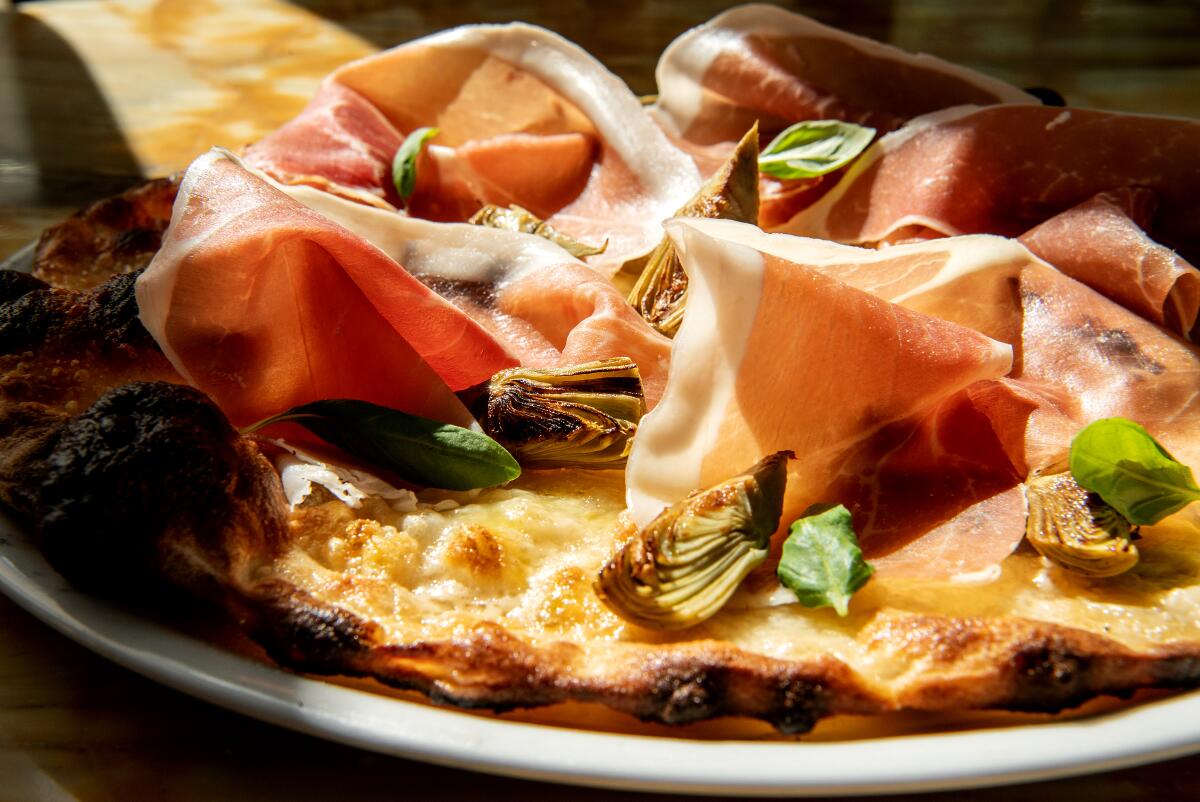
Carciofi e prosciutto pizza.
(Mariah Tauger / Los Angeles Times)
The hill Funke will forever die on concerns the texture he feels pasta should be cooked: two shades firmer than al dente, by how it registers against my teeth. He particularly leans this way for rigatoni and other cylinder shapes. I may be tattling on chef de cuisine Hannah Martin-Duarte and her team by saying that during the four meals I’ve had at the restaurant, Funke was around for two of them. When he was absent the pastas struck me as cooked a moment or two longer. I enjoyed them more.
In any case, pastas remain the heart of the menu. I love the gricia reliably, and also the all’amatriciana’s potent mix of tomato and guanciale fused onto curving rigatoni. I hope the bucatini in a pesto of bitter greens never vanishes: Among the menu’s whirl of meat and cheese, its heady sting clears the senses.
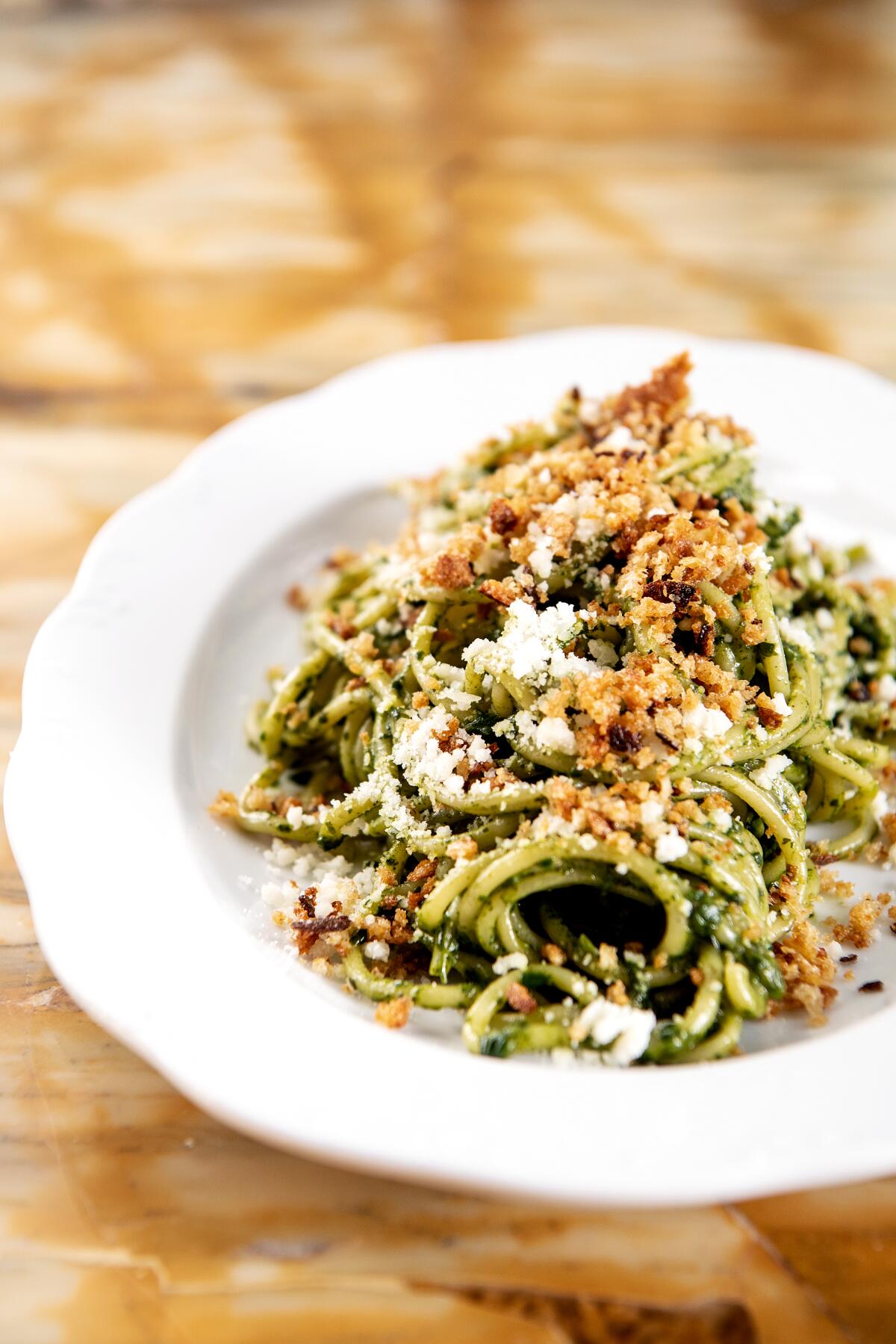
Bucatini con cicoria.
(Mariah Tauger / Los Angeles Times)
Consistency is the gremlin of massive operations like this, and occasionally the engineering of dishes falls short. A plate of carbonara came out rather gluey one night, and that matters when a dish of simple, impeccable ingredients costs $31. Saltimbocca rarely appears on modern Italian menus, and when the kitchen nails the union of vitello and prosciutto in burro fuso (an emulsified butter sauce) the effect is velvety and on the thrilling edge of salty. During a recent meal the meat was overcooked, blowing past the moment of alchemy into an unremarkable mass.
A restaurant of such glamorous scale needs a strong third act, and Funke wisely hired pastry chef Shannon Swindle, who had recently been working as a server at Felix after several years with the Lucques Group. He knows a hefty Roman meal needs a fresh California finale.
Maritozzo, a fluffy sweet bun filled with cream in a shape that resembles Pac-Man with his mouth full, hides a surprise: a pocket of ripe, macerated Harry’s Berries that lightens the whole affair. He saturates cake in olive oil without making it feel heavy, and his seasonal gelati and sorbets are suffused with enough flavor to make a grand conclusion on their own.
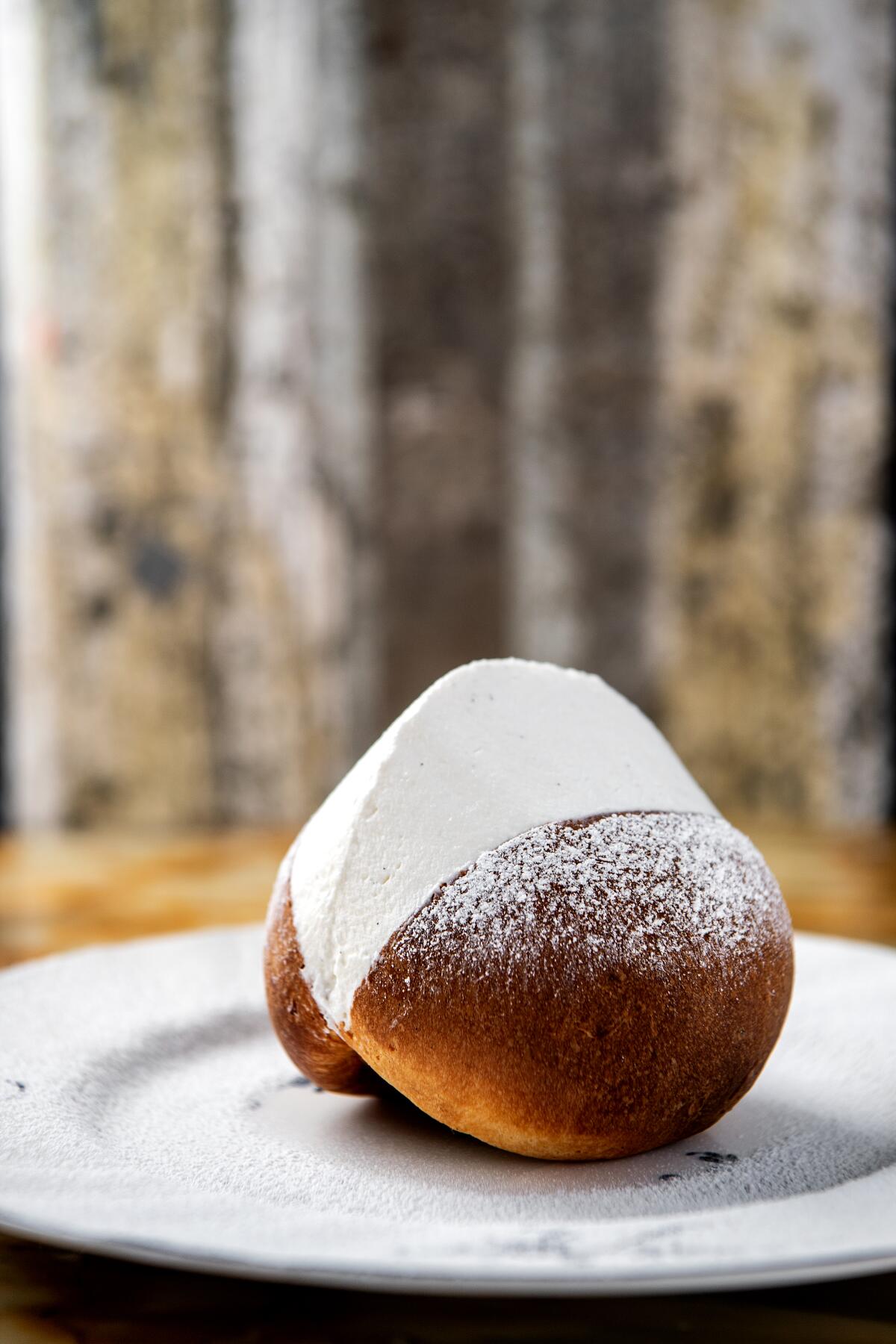
Maritozzo from pastry chef Shannon Swindle at Mother Wolf.
(Mariah Tauger / Los Angeles Times)
An amaro cart may trundle by. If you’re game, the Enrico Toro centerba forte is piney and minty and leaves you feeling settled as you drift into the night, past the people in the foyer likely waiting for your table.
In a phone interview Funke mentioned that he plans to open other regionally specific Italian restaurants; he’s currently researching the seafood and vegetable riches (and of course the pastas) of Catania, Sicily. A new Funke restaurant will always involve some razzle-dazzle, but I doubt he’ll attempt anything of this size again soon. There’s no need. With Mother Wolf he’s pulled off serious cooking while pulling in Beyoncé and the Obamas … and the rest of us jockeying for reservations.
Mother Wolf
1545 Wilcox Ave., Los Angeles, (323) 410-6060, motherwolfla.com
Prices: Starters $14-$34, most pizzas $24-$36, pastas $24-$32, entrees $32-$72, desserts $12-$18
Details: Open 5:30-9 p.m. Tuesday-Thursday, 5:30-10 p.m. Friday-Saturday. Full bar. Valet parking.
Recommended dishes: Fried squash blossoms, supplì al telefono, carciofi e prosciutto pizza, spaghettone alla gricia, branzino alla blace, maritozzo
